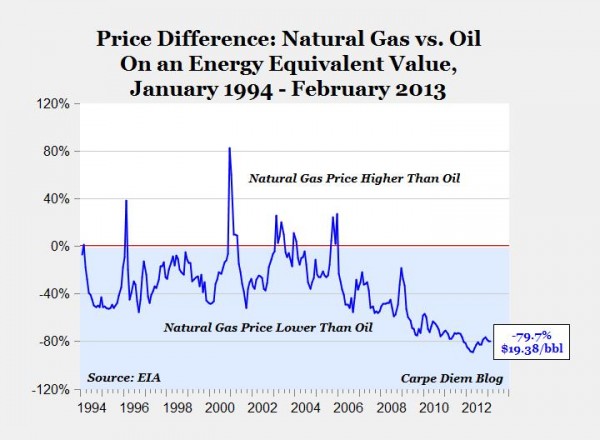America's energy renaissance has led to a near doubling of proved natural gas reserves since 2000, and natural gas cemented itself as the preferred cheap energy source domestically. Accordingly, natural gas now trades at a 75% discount to crude on an energy equivalent basis. The thesis for investing in natural gas infrastructure and natural gas vehicles will remain in place as long as such an economic incentive exists. Chart Industries, (GTLS 0.02%), Clean Energy Fuels and Westport Innovations each stand to benefit as natural gas maintains its cheap energy status.
Drum roll please – that one number is 5.8
5.8. It's a seemingly unimportant number. Rarely can such a number or one single data point sum up a thesis entirely, but if we look for the overarching drivers behind natural gas infrastructure development, I believe this instance is an exception. To determine the energy equivalent output of natural gas to crude oil, we must convert spot natural gas prices by a factor of 5.8, which is how many million BTU's that one barrel of oil produces. As long as the resulting number is less than the price of crude oil, natural gas is cheaper than oil for the equivalent amount of energy produced. Energy equivalent natural gas prices are currently $25.17 ($4.34/mmBTU spot Henry Hub), well below where WTI crude trades at $99.33/bbl.

Historical natural gas to crude oil energy equivalent discount
The trend is unlikely to change
Natural gas infrastructure, such as liquefaction facilities, a national footprint for LNG/CNG fueling stations, and natural gas powered automobile engines, all have one thing in common: They take time to develop, sometimes proceeding at what seems like a snail's pace. Let's admit it, we as consumers become accustomed to the norm (i.e. oil) and demand patterns are slow to change. Additionally, many industry factors slow the pace at which infrastructure can come online to support demand for natural gas (or vice versa that demand reacts to increased infrastructure). Fortunately, natural gas is likely to remain heavily discounted to crude oil for the foreseeable future. The U.S. Energy Information Administration is forecasting natural gas prices to increase by 25% through 2017 to $5.43/mmBTU, while crude oil falls to $92.00/bbl. The energy equivalent price is then $31.49, a still significant 66% discount to crude. Elevated tight gas production and reduced reliance upon imports will result in natural gas supplies increasing by 4.2% over the same period, while crude's increase lags behind at 1.9%.
3 companies benefiting from cheap natural gas
Chart Industries is the leading infrastructure supplier of cryogenic systems used in the transportation, purification and storage of natural gas. Gas must be cooled both to reach a liquid state and in the purification process. In addition, it must be stored at high pressure inside tanks whether being transported or used as a fuel source in vehicles. As natural gas has become an economical alternative in the U.S. (don't forget China as well), Chart's growth story has played out. The company reported a revenue increase of 18.6% year over year in the most recent quarter while EPS increased 30.6% year over year. Analysts are forecasting similar top- and bottom-line performance in 2014 with revenues and EPS increasing by 16.6% and 32.6%, respectively.
Clean Energy Fuels is a T. Boone Pickens backed venture that designs, builds, and operates a network of 440 CNG/LNG fueling stations in 32 states, of which 92 stations were opened in 2013. The company is investing to rationalize commercial freight operations across the lower 48 states. Year-to-date, Clean Energy Fuels has grown revenues by 13.9% year over year . Analysts are forecasting continued growth through 2014 with revenues increasing 21.9%.
Westport Innovations is the industry standard for natural gas engines used in heavy duty and everyday passenger vehicles. The company has key partnerships with Cummins to develop engines for commercial transportation applications and with Ford Motor Co. (F 0.72%) as its largest supplier of natural gas engines. Westport WING systems are offered across Ford's lineup of F-series pickup trucks and industrial vehicles. The company grew revenues in the third quarter by 51.5% year over year, and analysts expect a 41.4% increase through 2014 as natural gas engines become a viable alternative on a larger scale.
Final thoughts
What happens to one company is almost all but certain to affect the others, as Westport Innovations, Clean Energy Fuels, and Chart Industries are similarly beholden to future chapters of the natural gas story. With straightforward and simple analysis, though, one can start to realize it is an unlikely scenario that natural gas and crude oil will converge and close the energy equivalent gap anytime soon. Far too many factors point toward elevated natural gas production putting a ceiling on prices. Maybe such an improbable outcome of an industrywide ban on tight gas drilling or a far-fetched idea for clean-coal powered automobile engines would reduce drilling demand/supplies for natural gas.
Even so, significant headroom remains for natural gas prices. Natural gas would need to triple from current levels, along with a corresponding 24% drop for crude, before prices would be at parity. Companies will continue to invest in projects that build out our domestic natural gas infrastructure, and consumer demand for cheap fossil fuels should trail closely behind as long as natural gas is an economical alternative.